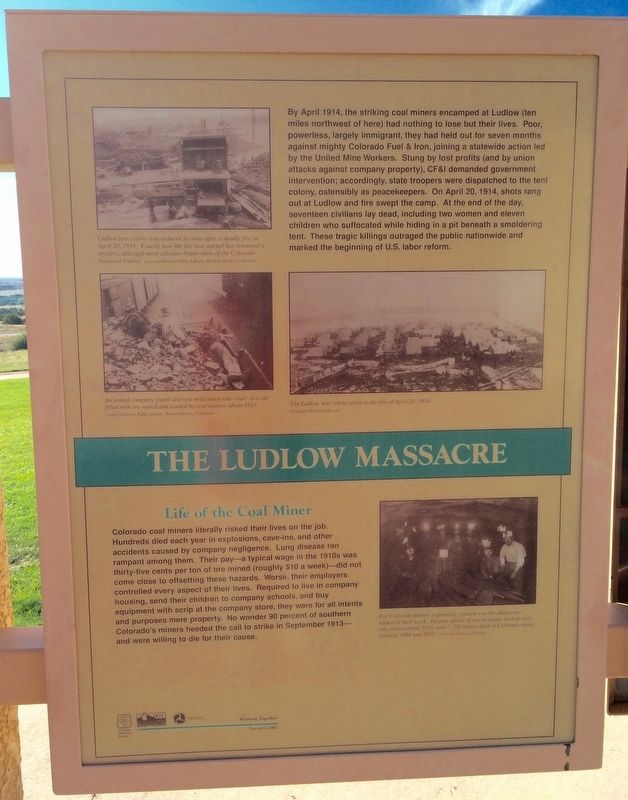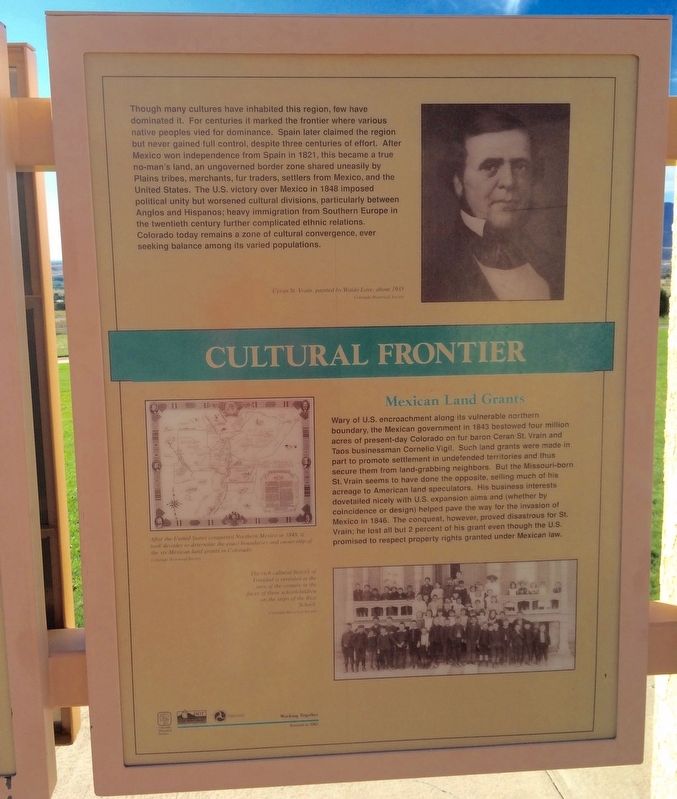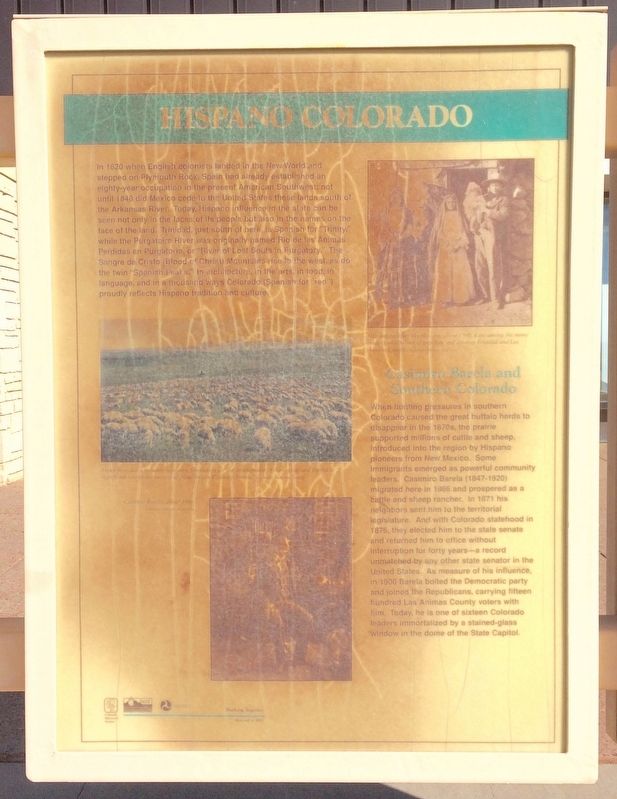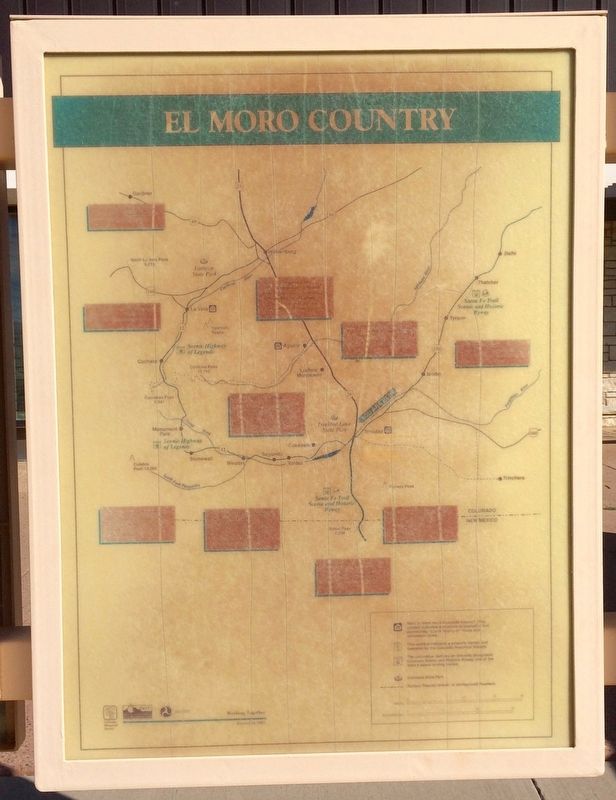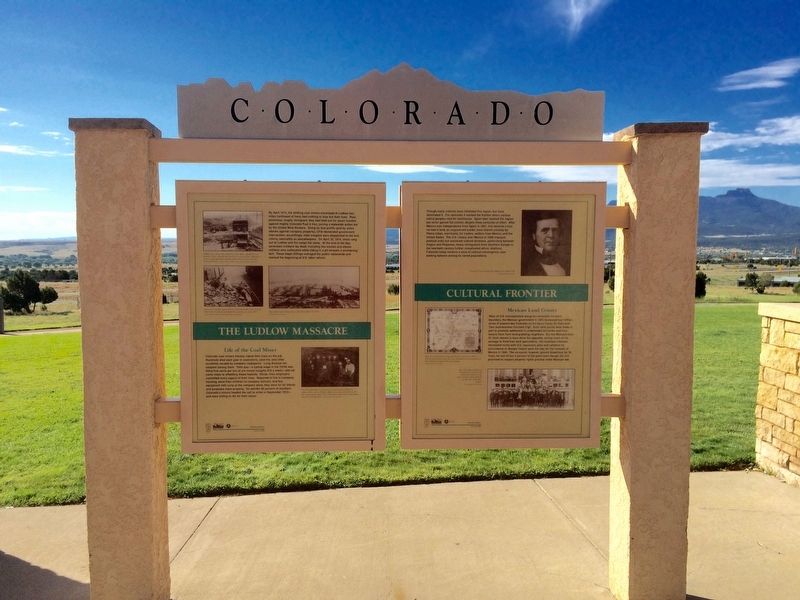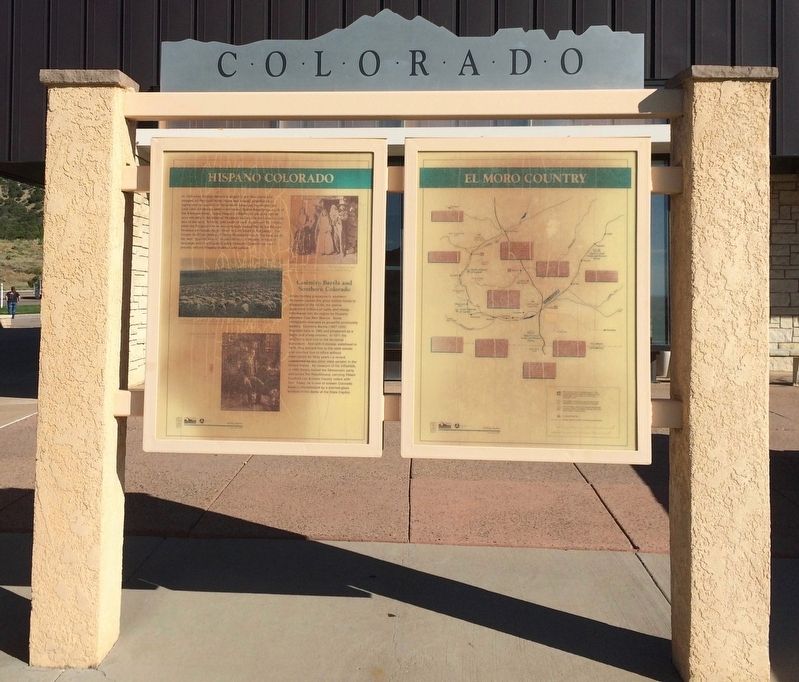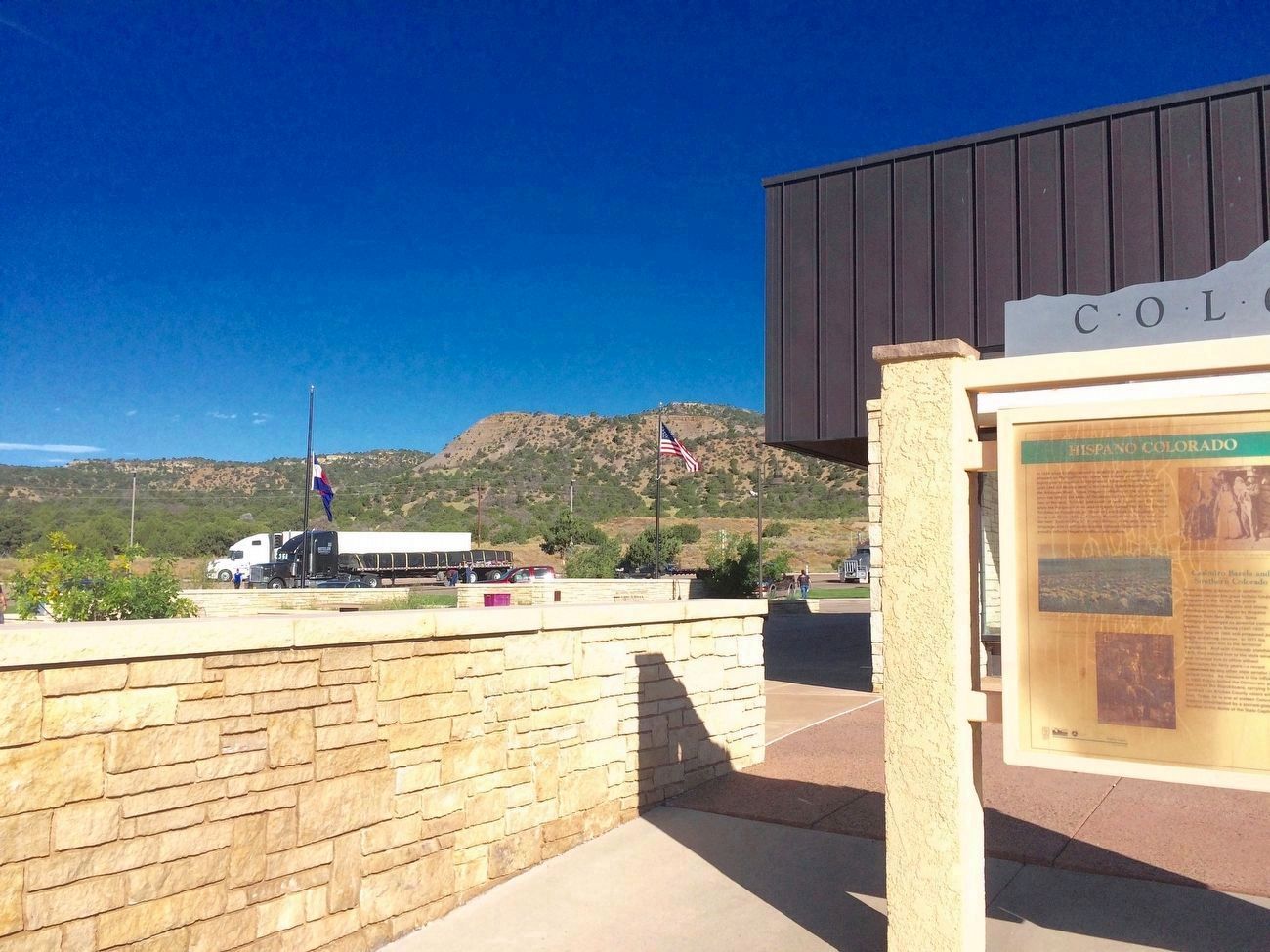Near Trinidad in Las Animas County, Colorado — The American Mountains (Southwest)
The Ludlow Massacre - Cultural Frontier / Hispano Colorado - El Moro Country
Panel 1
By April 1914, the striking coal miners encamped at Ludlow (ten miles northwest of here) had nothing to lose but their lives. Poor, powerless, largely immigrant, they had held out for seven months against mighty Colorado Fuel & Iron, joining a statewide action led by the United Mine Workers. Stung by lost profits (and by union attacks against company property), CF&I demanded government intervention; accordingly, state troopers were dispatched to the tent colony, ostensibly as peacekeepers. On April 20, 1914, shots rang out at Ludlow and fire swept the camp. At the end of the day, seventeen civilians lay dead, including two women and eleven children who suffocated while hiding in a pit beneath a smoldering tent. These tragic killings outraged the public nationwide and marked the beginning of U.S. labor reform.
Life of the Coal Miner
Colorado coal miners literally risked their lives on the job. Hundreds died each year in explosions, cave-ins, and other accidents caused by company negligence. Lung disease ran rampant among them. Their pay - a typical wage in the 1910s was thirty-five cents per ton of ore mined (roughly $10 a week) - did not come close to offsetting these hazards. Worse, their employers controlled every aspect of their lives. Required to live in company housing, send their children to company schools, and buy equipment with scrip at the company store, they were for all intents and purposes mere property. No wonder 90 percent of southern Colorado's miners heeded the call to strike in September 1913 - and were willing to die for their cause.
Also found on this panel:
Photo: Ludlow Tent Colony after fire
Ludlow tent colony was reduced to ruins after a deadly fire on April 20, 1914. Exactly how the fire was started has remained a mystery, although most scholars blame units of the Colorado National Guard.
Courtesy Denver Public Library, Western History Collection
Photo: Nat'l Guard in Ore Car
An armed company guard and two militiamen take cover in a car filled with ore mined and loaded by coal miners, about 1913
Courtesy Denver Public Library, Western History Collection
Photo: Ludlow Tent Colony before the fire
The Ludlow tent colony prior to the fire of April 20, 1914.
Colorado Historical Society
Photo: Mine rescue team
For Colorado miners, a pressing concern was the dangerous nature of their work. Despite efforts of rescue teams such as this one shown about 1910, over 1,700 miners died in Colorado mines between 1884 and 1912.
Colorado Historical Society
Panel 2
Though many cultures have inhabited this region, few have dominated it. For centuries it marked the frontier where various native peoples vied for dominance. Spain later claimed the region but never gained full control, despite three centuries of effort. After Mexico won independence from Spain in 1821, this became a true no-man's land, an ungoverned border zone shared unsteadily by Plains tribes, merchants, fur traders, settlers from Mexico, and the United States. The U.S. victory over Mexico in 1848 imposed political unity but worsened cultural divisions, particularly between Anglos and Hispanos; and heavy immigration from Southern Europe in the twentieth century further complicated ethnic relations. Colorado today remains a zone of cultural convergence, ever seeking balance among its varied populations.
Mexican Land Grants
Wary of U.S. encroachment along its vulnerable northern boundary, the Mexican government in 1843 bestowed four million acres of present-day Colorado on fur baron Céran St. Vrain and Taos businessman Cornelio Vigil. Such land grants were made in part to promote settlement in undefended territories and thus secure them from land-grabbing neighbors. But the Missouri-born St. Vrain seems to have done the opposite, selling much of his acreage to American land speculators. His business interests dovetailed nicely with U.S. expansion aims and (whether by coincidence or design) helped pave the way for the invasion of Mexico in 1846. The conquest, however, proved disastrous for St. Vrain; he lost all but 2 percent of his grant even though the U.S. promised to respect property rights granted under Mexican law.
Also found on this panel:
Photo: Ceran St. Vrain
Ceran St. Vrain, by Waldo Love, about 1935
Colorado Historical Society
Photo: Land Grants
After the United States conquered Northern Mexico in 1848, it took decades to determine the exact boundaries and ownership of the six Mexican land grants in Colorado shown here.
Colorado Historical Society
Photo: Schoolchildren
The rich cultural history of Trinidad is revealed at the turn of the century in the faces of these schoolchildren on the steps of the Rice School.
Colorado Historical Society
Photo: Apache Indian and Son
Apaches, like this father and son in the late nineteenth century, were among the many tribes that called the region now known as Las Animas County home.
Panel 3
In 1620 when English colonists landed in the New World and stepped on Plymouth Rock, Spain had already established an eighty-year occupation in the present American Southwest; and not until 1848 did Mexico cede to the United States these lands south of the Arkansas River. Today, Hispano influence in the state can be seen not only in the faces of its people but also in the names on the face of the land. Trinidad, just south of here, is Spanish for "Trinity," while the Purgatoire River was originally named Rio de las Animas Perdidas en Purgatorio, or "River of Lost Souls in Purgatory." The Sangre de Cristo (Blood of Christ) Mountains rise to the west, as do the twin "Spanish Peaks." In architecture, in the arts, in food, in language, and in a thousand ways Colorado (Spanish for "red") proudly reflects Hispano tradition and culture.
Casimiro Barela and Southern Colorado
When hunting pressures in southern Colorado caused the great buffalo herds to disappear in the 1870s, the prairie supported millions of cattle and sheep, introduced into the region by Hispano pioneers from New Mexico. Some immigrants emerged as powerful community leaders. Casimiro Barela (1847-1920) migrated here in 1866, where he prospered as a cattle and sheep rancher. In 1871 his neighbors sent him to the territorial legislature. And with Colorado statehood in 1876, they elected him to the state senate and returned him without interruption for forty years - a record unmatched by any other state senator in the United States. As measure of his influence, in 1906 Barela bolted the Democratic party and joined the Republicans, carrying fifteen hundred Las Animas County voters with him. Today, he is one of sixteen Colorado leaders immortalized by a stained-glass window in the dome of the State Capitol.
Also found on this panel:
Photo: Portrait of Casimiro Barela
Casimiro Barela, about 1900
Colorado Historical Society
Photo: Mexican Family
Hispano families like this one, about 1890, were among the many settlers who helped to populate and develop Trinidad and Las Animas County.
Colorado Historical Society
Photo: color postcard of sheep
Sheep provided a valuable economic foundation for the development of the region, not to mention a significant factor in the success of pioneers like Casimiro Barela.
Panel 4
Erected 1999 by Colorado Historical Society. (Marker Number 247.)
Topics and series. This historical marker is listed in these topic lists: Animals • Disasters • Settlements & Settlers. In addition, it is included in the Colorado - History Colorado series list. A significant historical month for this entry is April 1914.
Location. 37° 13.536′ N, 104° 29.642′ W. Marker is near Trinidad, Colorado, in Las Animas County. Marker can be reached from the intersection of El Moro Road (at milepost 18) and Linden Avenue (County Road 71.1). Located at the El Moro Colorado Department of Transportation Rest Area on southbound I-25, Exit 18. Touch for map. Marker is in this post office area: Trinidad CO 81082, United States of America. Touch for directions.
Other nearby markers. At least 8 other markers are within 4 miles of this marker, measured as the crow flies. Transportation on the Santa Fe Trail (within shouting distance of this marker); Santa Fe Trail (approx. 3.4 miles away); Christopher Carson (approx. 3.4 miles away); Trinidad's First City Building (approx. 3.9 miles away); Women & Children's March, 1914 (approx. 3.9 miles away); Cathay Williams (approx. 3.9 miles away); Welcome to Colorado - Trinidad Country / Trinidad - Army of the West (approx. 4 miles away); World War II Veterans Memorial (approx. 4 miles away). Touch for a list and map of all markers in Trinidad.
Also see . . . Wikipedia article on the Ludlow Massacre. (Submitted on September 12, 2016, by Mark Hilton of Montgomery, Alabama.)
Credits. This page was last revised on September 13, 2016. It was originally submitted on September 12, 2016, by Mark Hilton of Montgomery, Alabama. This page has been viewed 892 times since then and 41 times this year. Photos: 1, 2, 3, 4, 5, 6, 7. submitted on September 12, 2016, by Mark Hilton of Montgomery, Alabama.
